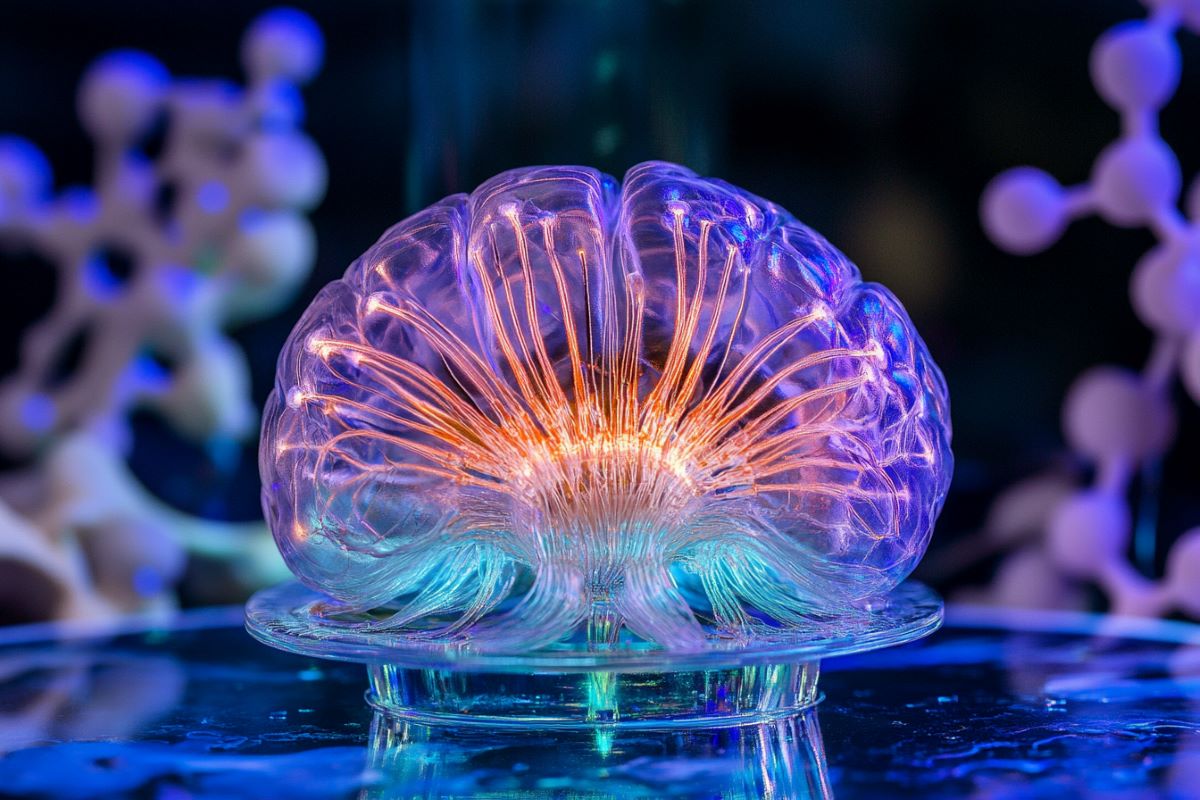Summary: A new “molecular lantern” technique allows researchers to monitor molecular changes in the brain non-invasively using a thin light-emitting probe. This innovative tool utilizes Raman spectroscopy to detect chemical changes caused by tumors, injuries, or other pathologies without altering the brain beforehand.
Unlike prior methods requiring genetic modifications, this approach analyzes natural brain tissue with high precision, offering significant potential for diagnosing and studying brain diseases. Future developments aim to integrate artificial intelligence to enhance diagnostic accuracy and explore diverse biomedical applications.
Key Facts:
- Non-Invasive Monitoring: The molecular lantern uses Raman spectroscopy to detect brain changes without altering tissue.
- Advanced Diagnostics: It identifies molecular changes in pathologies like tumors and trauma with high precision.
- AI Integration: Artificial intelligence could enhance diagnostic markers and classify pathological entities.
Source: CSIC
Monitoring the changes caused in the brain at the molecular level by cancer and other neurological pathologies in a non-invasive way is one of the great challenges of biomedical research.
A new technique, still in the experimental stage, achieves this by introducing light into the brains of mice using a very thin probe.
The innovation, which is published today in the journal Nature Methods, is ledby an international team including groups from the Spanish National Research Council (CSIC) and the Spanish National Cancer Research Centre (CNIO).

The authors refer to the new technique as a ‘molecular lantern’, as it provides information on the chemical composition of brain tissue in response to light. This allows analysis of molecular changes caused by tumours, whether primary or metastatic, and also by injuries such as head trauma.
The molecular lantern is a probe of less than 1 mm thick, with a tip just a thousandth of a millimetre (a micron), invisible to the naked eye. It can be inserted deep into the brain without causing damage (as an example, a human hair measures between 30 and 50 microns in diameter).
The probe is not yet ready for use in patients; for now it is primarily a ‘promising’ research tool in animal models that allows ‘monitoring molecular alterations caused by traumatic brain injury, as well as detecting diagnostic markers of brain metastasis with high accuracy,’ explain the authors of the paper.
The work has been carried out by the European consortium NanoBright, in which two Spanish groups participate, the one led by Liset Menéndez de la Prida at the Neuronal Circuits Laboratory of the Cajal Institute of the CSIC, and the Brain Metastasis Group of the CNIO directed by Manuel Valiente. Both have been involved in the biomedical research on NanoBright, while groups from Italian Institute of Technology and French institutions such as the Laboratoire Kastler Brossel, have developed the instrumentation.
Scanning the brain with light without altering it previously
Activating or recording brain function using light is not new. For example, the so-called optogenetic technique make it possible to monitor the activity of individual neurons with light. However, this requires introducing a gene into the neurons that makes them sensitive to light.
With the new technology now presented by NanoBright, it is possible to study the brain without altering it beforehand, which represents a paradigm shift in biomedical research.
The new molecular lantern is based on a technique called vibrational spectroscopy, which leverages the Raman effect—a unique property of light.
“When light interacts with molecules, it scatters in a way that depends on their composition and chemical structure.
“This scattering produces a distinct signal, or spectrum, that acts as a molecular fingerprint, providing detailed information about the composition of the illuminated tissue”, explain Liset M. de la Prida from CSIC.
“We can see any molecular change produced in the brain by a pathology or injury”
“This technology allows us to study the brain in its natural state; it is not necessary to alter it beforehand.
“But it also makes it possible to analyse any type of brain structure, not only those that have been genetically marked or altered, as was the case with the technologies used until now.
“With vibrational spectroscopy we can see any molecular change in the brain when there is a pathology”, explains Manuel Valiente, from the CNIO.
Raman spectroscopy is already used in neurosurgery, although in an invasive and less precise way.
“There have been studies of its use when operating on brain tumours in patients,’ says Valiente. In the operating room, once the bulk of the tumour has been surgically removed, it is possible to introduce a Raman spectroscopy probe to assess whether cancer cells remain in the area.
“That is, it is only used when the brain is already open and the hole is large enough. But these relatively large ‘molecular lanterns’ are incompatible with minimally invasive use in live animal models”.
For the CNIO group, one goal now is to find out whether the information provided by the probe allows “differentiating different oncological entities, for example, the types of metastases according to their mutational profiles, by their primary origin or from different types of brain tumours”.
Artificial intelligence to search for diagnostic markers
The Cajal Institute group has used the technique to investigate the epileptogenic zones surrounding traumativc brain injuries.
“We were able to identify different vibrational profiles in the same brain regions susceptible to epileptic seizures, depending on their association with a tumour or trauma.
“This suggests that the molecular shadows of these areas are affected differently, and can be used to separate different pathological entities by automatic classification algorithms including artificial intelligence”, explains Liset M. de la Prida.
“The integration of vibrational spectroscopy with other modalities for recording brain activity and advanced computational analysis with artificial intelligence will allow us to identify new high-precision diagnostic markers, which will facilitate the development of advanced neurotechnologies for new biomedical applications”, summarizes the CSIC researcher, Liset M. de la Prida.
About this neurotech, brain cancer, and AI research news
Author: Pilar Quijada
Source: CSIC
Contact: Pilar Quijada – CSIC
Image: The image is credited to Neuroscience News
Original Research: Closed access.
“Vibrational fiber photometry: label-free and reporter-free minimally invasive Raman spectroscopy deep in the mouse brain” by Liset Menéndez de la Prida et al. Nature Methods
Abstract
Vibrational fiber photometry: label-free and reporter-free minimally invasive Raman spectroscopy deep in the mouse brain
Optical approaches to monitor neural activity are transforming neuroscience, owing to a fast-evolving palette of genetically encoded molecular reporters.
However, the field still requires robust and label-free technologies to monitor the multifaceted biomolecular changes accompanying brain development, aging or disease.
Here, we have developed vibrational fiber photometry as a low-invasive method for label-free monitoring of the biomolecular content of arbitrarily deep regions of the mouse brain in vivo through spontaneous Raman spectroscopy.
Using a tapered fiber probe as thin as 1 µm at its tip, we elucidate the cytoarchitecture of the mouse brain, monitor molecular alterations caused by traumatic brain injury, as well as detect markers of brain metastasis with high accuracy.
We view our approach, which introduces a deep learning algorithm to suppress probe background, as a promising complement to the existing palette of tools for the optical interrogation of neural function, with application to fundamental and preclinical investigations of the brain and other organs.






